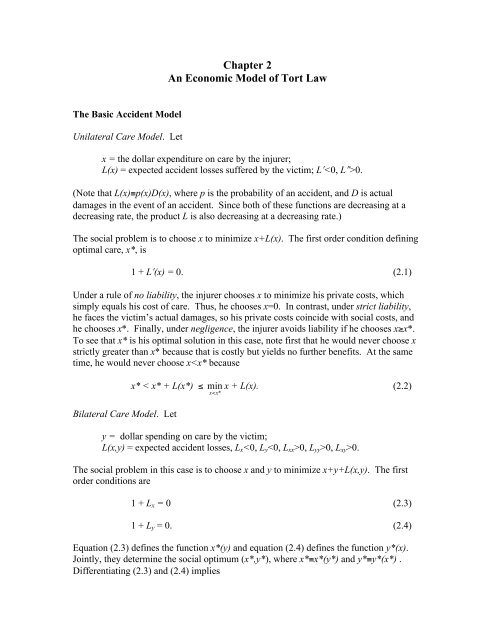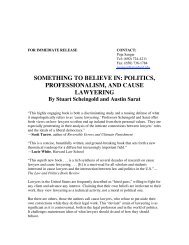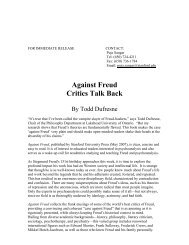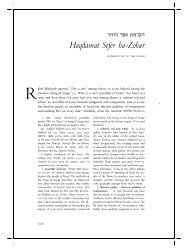Chapter 2 An Economic Model of Tort Law
Chapter 2 An Economic Model of Tort Law
Chapter 2 An Economic Model of Tort Law
Create successful ePaper yourself
Turn your PDF publications into a flip-book with our unique Google optimized e-Paper software.
<strong>Chapter</strong> 2<br />
<strong>An</strong> <strong>Economic</strong> <strong>Model</strong> <strong>of</strong> <strong>Tort</strong> <strong>Law</strong><br />
The Basic Accident <strong>Model</strong><br />
Unilateral Care <strong>Model</strong>. Let<br />
x = the dollar expenditure on care by the injurer;<br />
L(x) = expected accident losses suffered by the victim; L′0.<br />
(Note that L(x)≡p(x)D(x), where p is the probability <strong>of</strong> an accident, and D is actual<br />
damages in the event <strong>of</strong> an accident. Since both <strong>of</strong> these functions are decreasing at a<br />
decreasing rate, the product L is also decreasing at a decreasing rate.)<br />
The social problem is to choose x to minimize x+L(x). The first order condition defining<br />
optimal care, x*, is<br />
1 + L′(x) = 0. (2.1)<br />
Under a rule <strong>of</strong> no liability, the injurer chooses x to minimize his private costs, which<br />
simply equals his cost <strong>of</strong> care. Thus, he chooses x=0. In contrast, under strict liability,<br />
he faces the victim’s actual damages, so his private costs coincide with social costs, and<br />
he chooses x*. Finally, under negligence, the injurer avoids liability if he chooses x≥x*.<br />
To see that x* is his optimal solution in this case, note first that he would never choose x<br />
strictly greater than x* because that is costly but yields no further benefits. At the same<br />
time, he would never choose x0.<br />
The social problem in this case is to choose x and y to minimize x+y+L(x,y). The first<br />
order conditions are<br />
1 + L x = 0 (2.3)<br />
1 + L y = 0. (2.4)<br />
Equation (2.3) defines the function x*(y) and equation (2.4) defines the function y*(x).<br />
Jointly, they determine the social optimum (x*,y*), where x*≡x*(y*) and y*≡y*(x*) .<br />
Differentiating (2.3) and (2.4) implies
∂x*/∂y = −L xy /L xx < 0, and ∂y*/∂x = −L xy /L yy < 0. (2.5)<br />
These results reflect the substitutability <strong>of</strong> injurer and victim care, as shown in the graph<br />
below.<br />
Consider the Nash equilibrium choices <strong>of</strong> x and y under the various liability rules. First,<br />
under no liability, the injurer will choose x=0 for any y. The victim thus faces her full<br />
damages and so chooses y*(0)>y*. The victim, therefore, takes more than the first, best<br />
level <strong>of</strong> care to compensate for the injurer’s lack <strong>of</strong> care (though her care is efficient,<br />
given x=0). The situation is reversed under strict liability. Specifically, the victim is<br />
fully compensated and so chooses y=0, while the injurer faces full damages and so<br />
chooses x*(0)>x* (See the graph).<br />
Now consider a negligence rule. We will show that (x*, y*) is a Nash equilibrium. First,<br />
suppose that y=y*. The injurer then chooses x* because<br />
x* < x* + L(x*,y*) ≤<br />
min<br />
x + L(x,y*). (2.6)<br />
x< x *<br />
Now suppose that x=x*. The victim then bears her own losses and so chooses y to<br />
minimize y+L(x*,y), which yields y*(x*)=y*. The logic is the same for any <strong>of</strong> the<br />
various negligence rules: namely, negligence with a defense <strong>of</strong> contributory negligence,<br />
strict liability with contributory negligence, and comparative negligence with a due<br />
standard at x*.<br />
Sequential Care Accidents<br />
Injurer Moves First. Suppose the injurer moves first and chooses xy*. That is, the victim should take<br />
compensating precaution. Note that simple negligence does not achieve this outcome<br />
because the injurer has violated the due standard and thus is fully liable. The victim,<br />
therefore, chooses y=0. Contributory negligence can induce the victim to take care in<br />
this case, but the due standard must be set at y*(x). Note, however, that this requires the<br />
victim to be able to observe the injurer’s care choice before making her own choice.<br />
Victim Moves First. Now suppose that the victim moves first and chooses yx*. Again, this involves compensating<br />
precaution. Note that simple negligence does induce efficient care in this case, but again,<br />
the due standard must be set at x*(y) rather than x*. In contrast, contributory negligence<br />
will result in no care by the injurer because y
y<br />
x*(y)<br />
y*(0)<br />
y*<br />
y*(x)<br />
x* x*(0) x

















